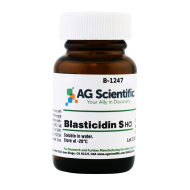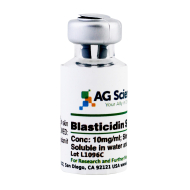Blasticidin S is an antibiotic used by scientists in bio-research to select cells modified by genetic engineering. It inhibits the growth of a wide range of prokaryotic and eukaryotic cells by interfering with protein synthesis. Blasticidin S allows the selection and maintenance of cells expressing the blasticidin-resistance gene.
Blasticidin S is an antibiotic used by scientists in bio-research to select cells modified by genetic engineering. It inhibits the growth of a wide range of prokaryotic and eukaryotic cells by interfering with protein synthesis. Blasticidin S allows the selection and maintenance of cells expressing the blasticidin-resistance gene. Blasticidin S is a peptidyl nucleosideantibiotic isolated from the culture broth of Streptomyces griseochromogenes. It specifically inhibits protein synthesis in both prokaryotes and eukaryotes through inhibition of peptide-bond formation in the ribosomal machinery. It is used to select transfected cells carrying bsr or BSD resistance genes. Blasticidin S specifically inhibits protein synthesis in both prokaryotes and eukaryotes through inhibition of peptide-bond formation in the ribosomal machinery.
RESISTANCE GENES Three blasticidin-resistance genes have been cloned and sequenced: an acetyl transferase gene, bls, fromStreptoverticillum sp. JCM 4673, a blasticidin producer strain, and two deaminase genes, bsr, from Bacillus cereus and BSD from Aspergillus terreus. Both genes, bsr and BSD, are used as dominant selectable markers for transformation experiments in mammalian and plant cells. Although Blasticidin S was developed as a selection agent for mammalian cells, the bsr and BSD resistance genes can also be used in E. coli. After nitrosoguanidine mutagenesis, mouse leukemia L5178Y cells a mutant cell (Bla-R) resistant to blasticidin S were isolated, an inhibitor of protein synthesis. Neither growth nor leucine incorporation into hot-acid insoluble fraction of Bla-R cell was inhibited by 5 to 20 μg/ml blasticidin S, which almost completely blocked protein synthesis as well as growth of the parental L5178Y cells. However, other inhibitors such as fusidic acid, cycloheximide, ricin D or L-asparaginase blocked protein synthesis in Bla-R cells to the same extent as in L5178Y cells. Protein synthesis in vitro using S-30 extracts from the parental cell line L5178Y was almost completely blocked in the presence of the antibiotic, while no inhibition by blasticidin S occurred when S-30 extracts from Bla-R mutant cells were used. Protein synthesis assays were made by using the S100 fraction from rat liver together with ribosomes from either L5178Y cells or Bla-R cells. Blasticidin S inhibited protein synthesis when ribosomes were derived from L5178Y cells, but not from Bla-R mutant. OPTIMIZED RESISTANCE GENES Exogenous DNA, such as resistance genes from bacterial origin, may be poorly suitable for expression in mammalian cells. First, codon usage in bacteria is very different from mammalian codon usage. Then, and even more crucial, the foreign (bacterial) DNA composition in CpG dinucleotides is very different from the CpG distribution in mammalian DNA. This difference elicits two phenomena which negatively affect gene expression: recognition of the bacterial DNA as foreign by the mammalian immune system, and methylation on the cytosine residue of CpG leading to gene silencing. Presence of methylcytosine alters the binding of transcriptional factors and other proteins to DNA and also attracts methyl-DNA-binding proteins that modify chromatin structure, resulting in loss of gene expression.To avoid bsr gene silencing in eukaryotic expression vectors, due to the presence of CpG dinucleotides, a functional reduced-CpG bsr gene is available (cf. vectors). Codon usage in this synthetic gene has also been modified. SOURCES: IZUMI M., MIYAZAWA H., KAMAKURA T.,YAMAGUCHI I.
